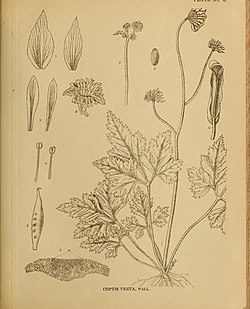Biology:Coptis teeta
| Coptis teeta | |
|---|---|

| |
| Scientific classification | |
| Kingdom: | Plantae |
| Clade: | Tracheophytes |
| Clade: | Angiosperms |
| Clade: | Eudicots |
| Order: | Ranunculales |
| Family: | Ranunculaceae |
| Genus: | Coptis |
| Species: | C. teeta
|
| Binomial name | |
| Coptis teeta | |
| Synonyms | |
|
Coptis teetoides | |
Coptis teeta is a rare species of flowering plant in the buttercup family.
Medicinal uses
It is a species of importance in Chinese herbology. Known as Yunnan goldthread (Chinese: 雲南黃連), its rhizome is used as an antimicrobial and anti-inflammatory.[2]
Habitat
A number of factors contribute to its endangerment. It is endemic to a very small area in the eastern Himalayas where its habitat is rapidly declining, due in part to deforestation, it is over-collected for medicinal use, and its reproductive success is low.[3] The plant is cultivated on a small scale in Yunnan using techniques that aim to conserve the species within its natural habitat.[2] The Lisu people of the local area earn much of their income from cultivation of the plant, which they grow using traditional agroforestry methods that have little adverse impact on the ecosystem.[4]
References
- ↑ "Coptis teeta". 16 July 2014. https://www.iucnredlist.org/species/50126583/50131320.
- ↑ 2.0 2.1 Huang, J.; Long, C. (2007). "Coptis teeta-based agroforestry system and its conservation potential: A case study from northwest Yunnan". Ambio 36 (4): 343–49. doi:10.1579/0044-7447(2007)36[343:CTASAI2.0.CO;2]. PMID 17626473.
- ↑ Pandit, M. K.; Babu, C. R. (1998). "Biology and conservation of Coptis teeta Wall. – an endemic and endangered medicinal herb of Eastern Himalaya". Environmental Conservation 25 (3): 262–72. doi:10.1017/S0376892998000320.
- ↑ Huang, J.; Long, C. (2006). "Traditional cultivation of Coptis teeta and its values in biodiversity con-servation". Biodiversity Science 14 (1): 79–86. doi:10.1360/biodiv.050092.
Wikidata ☰ Q5169052 entry
 |


